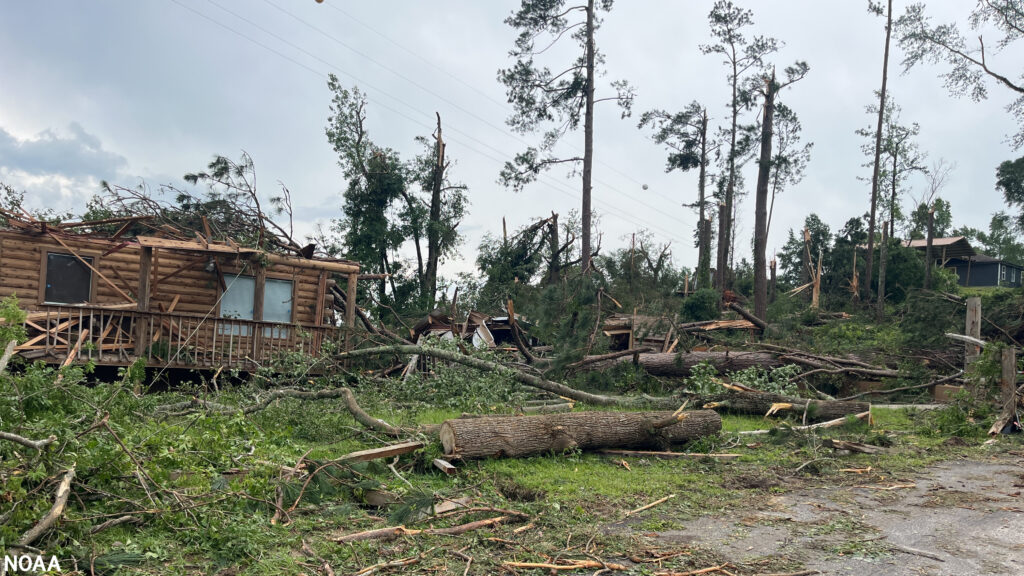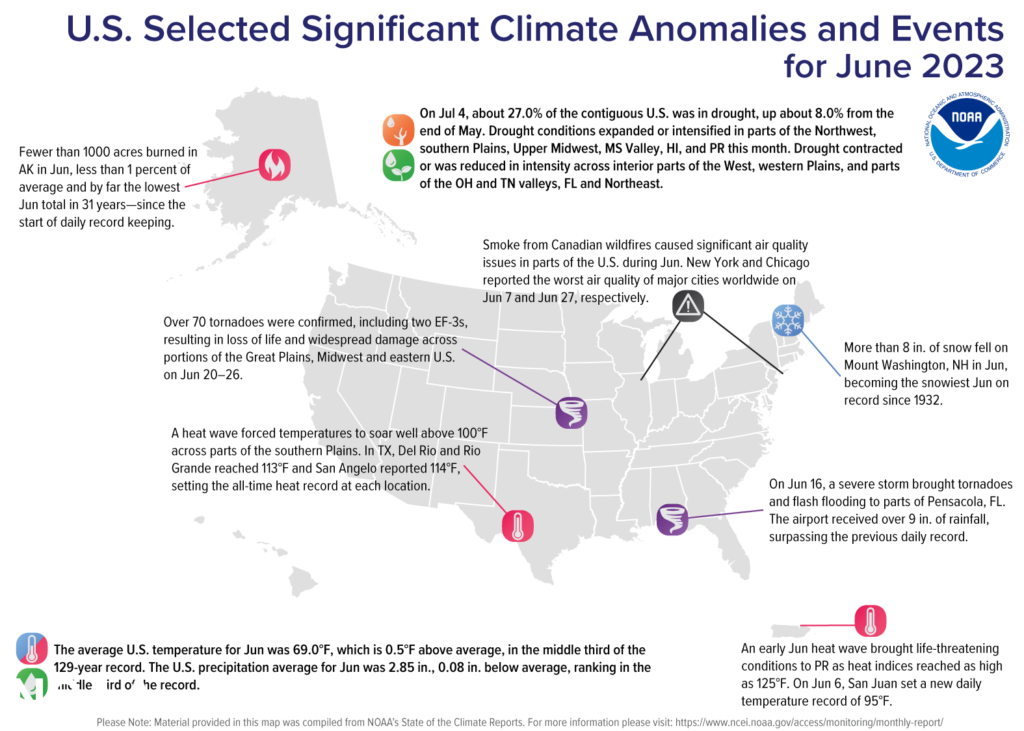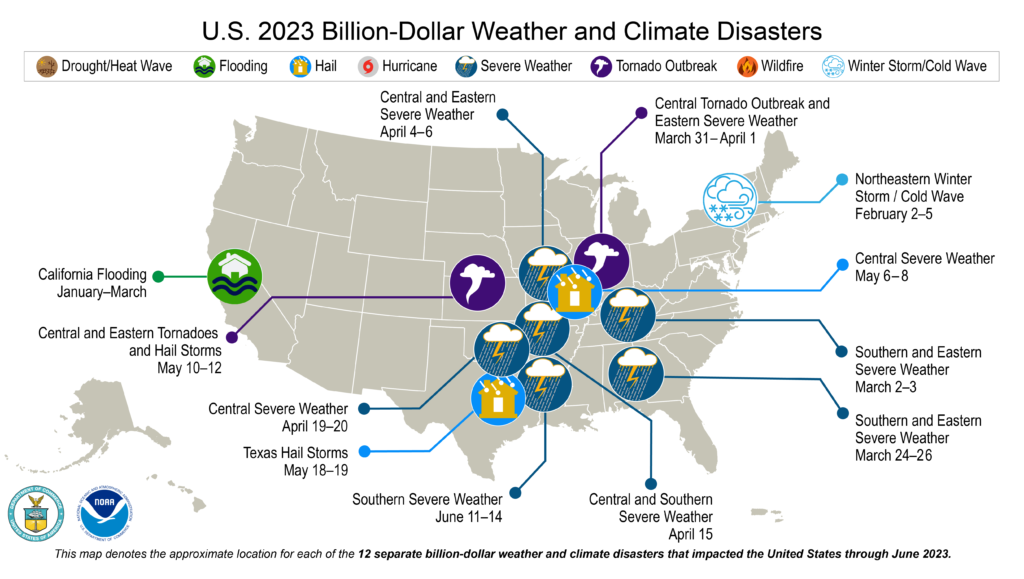- Fragile Planet Offers a Nighttime Wildlife Experience
- Falcons Soccer Off & Running
- Cameron County Receives Funds to Improve Two Parks
- Falcons Complete First Half of 32-6A
- School District to Help out Victims of California Wildfires
- Sand Castle Days Continued Despite Unexpected Weather
- Ready for District
- Discussion of Garbage Dumpster Rates, Agreements Between State & City on Highway Regulations, and More
- 31st Annual Shrimp Cook-Off is Right Around the Corner
- LFHS Cross Country
June Marked By Record-Setting U.S. Heat Waves, Severe Weather
- Updated: July 22, 2023
Nation struck with 12 separate billion-dollar disasters so far this year

June 2023 was record hot for some parts of the U.S., while other locations were roiled by severe weather and poor air quality, according to experts from NOAA’s National Centers for Environmental Information.
The year so far has also brought 12 separate billion-dollar weather and climate disasters to the nation — including tornado outbreaks, extreme flooding and a winter storm.
Below are more highlights from NOAA’s U.S. monthly climate report for June:
Climate by the numbers
June 2023
The average June temperature across the contiguous U.S. was 69.0 degrees F (0.5 of a degree above average), ranking in the middle third of the 129-year climate record.
Temperatures were above average from the Pacific Northwest to the northern Plains, as well as in the southern Plains and the Florida Peninsula. North Dakota saw its third-warmest June on record, while Louisiana and Minnesota each had a top-10 warmest June on record. Meanwhile, West Virginia and Virginia had their ninth- and 10th-coolest Junes on record, respectively.
June precipitation across the U.S. was 2.85 inches — 0.08 of an inch below average — ranking in the middle third of the historical record.
Wisconsin and Michigan each had their fifth-driest June on record, while Illinois and Missouri both had a top-10 driest June. Wyoming saw its third-wettest June on record with Colorado and Maine having one of their top-10 wettest Junes.

Year to date (YTD, January through June 2023)
The YTD average temperature for the contiguous U.S. was 49.2 degrees F, (1.7 degrees above the 20th-century average), ranking as the 21st-warmest such YTD on record. Florida’s January–June period ranked as its warmest on record while Massachusetts had its second-warmest. An additional 27 states had a top-10 warmest such YTD, while no state saw its top-10 coolest January–June.
The YTD precipitation total was 15.70 inches, 0.39 of an inch above average, which ranked in the middle-third of the record. Precipitation was above average from California to the Rockies and in parts of the southern Mississippi Valley, northern Great Lakes, Southeast and Northeast. Conversely, precipitation was below average across parts of the Northwest, northern and central Plains, Southwest, central Mississippi Valley, Mid-Atlantic and along parts of the Gulf Coast.
Billion-dollar disasters (January–June)
There were 12 individual billion-dollar weather and climate disasters across the U.S. during the first six months of 2023, including:
- One winter storm event.
- One flooding event.
- 10 severe weather events.
These events caused 100 direct and indirect fatalities and produced more than $32.7 billion in damages, Consumer Price Index (CPI)-adjusted. This puts this year’s number of events and price tag in second place, behind the first six months of 2017 (14 disasters) and 2021 ($42.5 billion), respectively.
Since 1980, when NOAA began tracking these events in the U.S., the nation has sustained 360 separate weather and climate disasters where overall damages/costs reached or exceeded $1 billion (based on the CPI adjustment to 2023) per event. The total cost of these 360 events exceeds $2.570 trillion.

Other notable highlights from this report
The heat was on: A series of heat waves brought record-breaking temperatures to portions of the U.S. during June 2023.
An early June heat wave brought life-threatening conditions to Puerto Rico as heat index values reached as high as 125 degrees F. On June 6, San Juan set a new daily temperature record of 95 degrees F.
A heat wave brought record heat to portions of the Northeast, Mid-Atlantic and Great Lakes during early June. Daily temperature records were set in parts of Michigan, New York and Vermont.
A heat wave had temperatures soar well above 100 degrees F across parts of the southern Plains. On June 24, the temperature at Rio Grande Village, Texas, topped out at 119 degrees F — 1 degree below the all-time temperature record for the state.
Severe weather struck several locations: A number of weather systems produced severe thunderstorms and tornadoes that impacted portions of the U.S. in June.
June 14-19: A tornado outbreak, including two EF-3 tornadoes, occurred across parts of the southern U.S. and Ohio Valley.
June 16: A severe storm brought tornadoes and flash flooding to parts of Pensacola, Florida. Pensacola International Airport received more than nine inches of rainfall, surpassing the previous daily record set in 1985.
June 20-26: More than 70 tornadoes were confirmed, including two EF-3 tornadoes, resulting in loss of life and widespread damage across portions of the Great Plains, Midwest and eastern U.S.
Wildfires sent smoke southward: Thick smoke from Canadian wildfires created air quality issues for millions of people in portions of the Northeast and Great Lakes this June.
June 7: Around 100 million people across 16 states were under air quality alerts while New York City reported the worst air quality of major cities worldwide.
June 27: Wildfire smoke impacted a large portion of the Midwest, resulting in the city of Chicago having the worst air quality of major cities worldwide.



